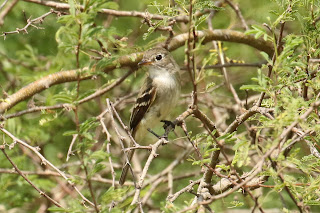Last Wednesday I was leading a butterfly trip for the Rio Grande Valley Birding Festival and the temperature was pushing 90F. The participants were sweating and we saw 55 species of butterflies. But by Sunday the high droped to the mid 60's and were were lucky to get twenty species. And last night a real blast of cold air came in. It's 49F and the butterflies are gone. But warm blooded birds can handle the cold so I threw out some seed, put out a couple of oranges and filled the hummingbird feeders. This young male Selasphorus has some orange flecking on the back so I'm calling it a Rufous Hummingbird. I could not get any good tail shots. Hope it hangs around and proves me wrong and molts into an Allen's.
Buff-bellied Hummingbirds are easy to ID.
This bright green-backed green-crowned hummer with a dark mask seems good for a female Ruby-throated.
I think this poor tailess one is also Ruby-throated.
I think this one with a dusky throat and dull crown is a Black-chinned but I'm not sure.
Golden-fronted Woodpeckers like the oranges.
Got our first American Robin for the year. I saw it through the window but it failed to cooperate for the camera. We get very few of them.
Two days ago a flock of four White-crowned Sparrows was a nice surprise.
A late Yellow Warbler is still hanging around.
We're supposed to stay below 60 for most of the coming week. Hope the cool weather brings some more migrants. Golden-crowned Kinglets and Red-breasted Nuthatches are being reported in the Valley so our yard is ready for 'em.





























































